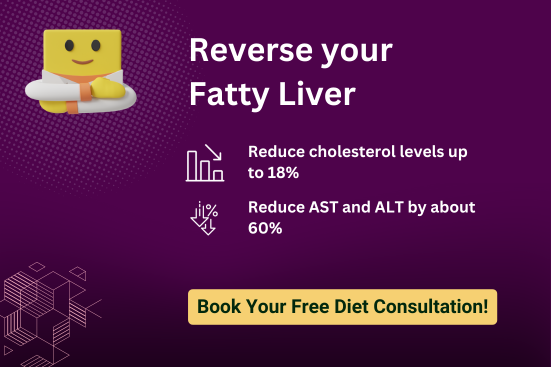A Dietary Guide to Gifting Your Fatty Liver a Long Life

Unmasking Grade 1 Fatty Liver: Causes, Symptoms, Diagnosis, and Effective Reversal Strategies
06 Mar 2024
Have you ever heard of Grade 1 fatty liver? Probably not. Yet, it’s a common health condition that remains largely unknown to many of us. Imagine a condition that silently chips away at your health while you remain blissfully unaware! Often asymptomatic, Grade 1 fatty liver quietly infiltrates your liver cells with fat, resulting from various contributing factors. The culprits? Obesity, diabetes, high cholesterol, and regular alcohol intake top the list.
In this blog post, we’ll delve into the causes of Grade 1 fatty liver—how it develops silently within your body and how symptoms surface when they do. We’ll then walk you through the diagnostic procedures that medical professionals apply to confirm its presence. Lastly, we’ll reveal practical steps towards reversing the condition through lifestyle transformations. Whether you’re grappling with this diagnosis or simply want to arm yourself with preventative knowledge, this guide will unpack everything you need to know about Grade 1 fatty liver.
Did you know? The liver is the only organ that can renew its damaged cells into brand-new ones.
A Peek Into Grade 1 Fatty Liver
When we talk about a ‘fatty liver’, we’re referring to the buildup of excess fat in the liver cells, a situation that isn’t quite as benign as it sounds. In its initial stage, known as Grade 1, this condition often tiptoes around your health, causing no noticeable symptoms.
However, don’t let this quiet beginning fool you. The absence of symptoms does not mean there’s nothing to worry about. Left unchecked, Grade 1 Fatty Liver can progress to more serious stages, damage your liver, and cause other health problems down the line.
Unraveling the Causes
Delving deeper into the causes of Grade 1 Fatty Liver can help us understand how this condition sneaks into our lives. Here are some of the major contributing factors:
- Obesity
- Cholesterol
- Diabetes
- High blood pressure
- Metabolic syndrome.
Other causes of grade 1 fatty liver disease include excessive alcohol intake, malnutrition, HIV or certain cancer treatments, exposure to toxins, and rare genetic conditions such as Wilson’s disease.
Spotting the Silent Symptoms
The tricky part about diagnosing Grade 1 Fatty Liver is the lack of overt symptoms. Often, patients walk into their doctor’s office for an entirely different reason, only to discover they have fatty liver disease. However, if any symptoms do appear, they might include fatigue or discomfort around the upper right abdomen. Therefore, it’s crucial to listen to your body and seek medical advice if you notice anything out of the ordinary.
Detective Work: Diagnosing the Condition
Diagnosing Grade 1 Fatty Liver involves a bit of detective work. Blood tests often serve as the first clue, revealing liver enzymes higher than usual. Imaging studies such as Ultrasonography or Computed Tomography (CT scan) can provide a visual confirmation of the fat accumulation in the liver. A liver biopsy, although more invasive, provides the most definitive diagnosis.
Turning the Tide: Reversal Strategies

The good news is that Grade 1 Fatty Liver doesn’t have to be a life sentence. Lifestyle changes can go a long way in reversing this condition. Exercising for weight loss and following a healthy diet are your best allies here.
Shedding those extra kilos can help reduce the fat in your liver. Regular exercise for grade 1 fatty liver not only aids weight loss but also improves overall liver function. A balanced diet for grade 1 fatty liver should be low in saturated fats and high in fibre.
Quick recipe: Marinate chicken breast with lemon juice, garlic, and herbs for thirty minutes. Grill to perfection and serve with steamed vegetables for a healthy, liver-friendly dinner.
A Quick Overview
In wrapping up, it’s clear that understanding the causes and symptoms associated with Grade 1 Fatty Liver is the first step towards managing this condition effectively. A positive change in lifestyle involving a well-rounded diet and consistent exercise appears to be the most effective fatty liver grade 1 treatment strategy. Keeping aware of your body’s signals, along with regular check-ups, can help you monitor and control this condition to lead a healthier life.
At tatvacare.in, we are committed to providing you with the most accurate and relevant information about medical conditions like these. Our mission is to empower you with the knowledge to take control of your health. Don’t hesitate to get in touch or explore our website further for more advice on managing conditions like Grade 1 Fatty Liver. Our team is always ready to provide support, answer queries, and guide you on your journey towards better health.

FAQs
Q. Can grade 1 fatty liver progress to more severe forms?
A: While grade 1 fatty liver is unlikely to progress rapidly, it is essential to monitor and manage the condition because it can eventually advance to more severe stages, such as cirrhosis.
Q. Are there noticeable symptoms for grade 1 fatty liver disease?
A: Typically, individuals with grade 1 fatty liver disease do not exhibit visible symptoms. It’s often discovered during routine medical check-ups when a doctor identifies abnormalities in liver function tests or notices an enlarged liver during a physical examination.
Q. Does everyone who has grade 1 fatty liver need medical intervention?
A: Not necessarily. For those experiencing no symptoms and whose condition is well managed through lifestyle adjustments, medical intervention may not be required. Regular monitoring remains vital.
Q. Why is it difficult to pinpoint the exact cause of fatty liver?
A: The precise mechanism behind fatty liver formation is not fully understood. Multiple factors likely interact to promote the development of fatty liver, making it challenging to identify a single causative agent
Q. What strategies can be adopted to prevent grade 1 fatty liver?
A: Prevention strategies centre around maintaining a healthy lifestyle. Regular exercise, a balanced diet low in fats and sugars, moderate alcohol consumption, and regular health check-ups can go a long way in preventing the onset of this condition.

Medically reviewed by
Dr. Krunal Chaudhari 
MBBS, MD
Recent Blog
- Virtual Twin Patients: What Indian Doctors Can Learn from the Future of Surgical Planning
- Can AI Deskill Doctors? The Lancet Warns of Risks – Here’s How You Stay in Control
- What India’s AI Push Means for Small Clinics
- Top 5 Myths Doctors Believe About Going Digital and Why They’re Wrong
- Clinic Burnout Is Real, Here’s How EMR Can Help Without Getting in the Way…
Archives
Categories
- Asthma (20)
- Diabetes (15)
- Fatty Liver (20)
- High Blood Pressure (2)
- High cholesterol (2)
- Hypertension (2)
- Insulin Resistance (1)
- Obesity (8)
- PCOS (6)
- TatvaPractice (18)
Let’s Connect
Quick contact




